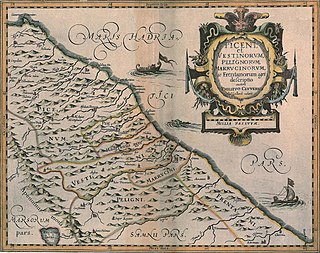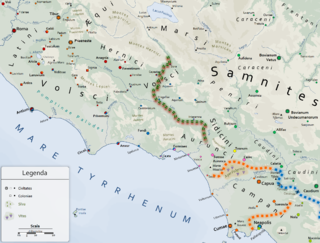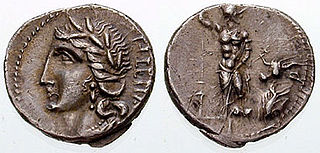Related Research Articles

Angitia was a goddess among the Marsi, the Paeligni and other Oscan-Umbrian peoples of central Italy. She was associated in antiquity with snake-charmers who claimed her as their ancestor. Roman interpretations probably obscure her Marsian significance.

The Sabines were an Italic people who lived in the central Apennine Mountains of the ancient Italian Peninsula, also inhabiting Latium north of the Anio before the founding of Rome.

The Hernici were an Italic tribe of ancient Italy, whose territory was in Latium between the Fucine Lake and the Sacco River (Trerus), bounded by the Volsci on the south, and by the Aequi and the Marsi on the north.

The Aequi were an Italic tribe on a stretch of the Apennine Mountains to the east of Latium in central Italy who appear in the early history of ancient Rome. After a long struggle for independence from Rome, they were defeated and substantial Roman colonies were placed on their soil. Only two inscriptions believed to be in the Aequian language remain. No more can be deduced than that the language was Italic. Otherwise, the inscriptions from the region are those of the Latin-speaking colonists in Latin. The colonial exonym documented in these inscriptions is Aequi and also Aequicoli. The manuscript variants of the classical authors present Equic-, Aequic-, Aequac-. If the form without the -coli is taken as an original, it may well also be the endonym, but to date further evidence is lacking.

Vestini were an Italic tribe who occupied the area of the modern Abruzzo, included between the Gran Sasso and the northern bank of the Aterno river. Their main centres were Pitinum (near modern L'Aquila), Aufinum (Ofena), Peltuinum, Pinna (Penne) and Aternum (Pescara, shared with the Marrucini).
The Paeligni or Peligni were an Italic tribe who lived in the Valle Peligna, in what is now Abruzzo, central Italy.

Aequian is an extinct Italic language presumed spoken by the people the Romans termed Aequi and Aequicoli living in the Alban hills of northeast Latium and the central Apennines east of them during the early and middle Roman Republic; that is, approximately from the 5th to the 3rd century BC, when they were defeated by the armies of Rome and were subsequently Romanized. As the area was heavily colonized by Latin speakers from Rome, most of the inscriptions from there are in Latin. Two undated inscriptions appear to be in a different dialect, termed Aequian by the scholars with the presumption that in fact they represent the language of the entire pre-Roman tribe. Not enough text survives to deduce any more than that it belonged to the Italic branch of the Indo-European language family.

Juno was an ancient Roman goddess, the protector and special counsellor of the state. She was equated to Hera, queen of the gods in Greek mythology and a goddess of love and marriage. A daughter of Saturn and Ops, she was the sister and wife of Jupiter and the mother of Mars, Vulcan, Bellona, Lucina and Juventas. Like Hera, her sacred animal was the peacock. Her Etruscan counterpart was Uni, and she was said to also watch over the women of Rome. As the patron goddess of Rome and the Roman Empire, Juno was called Regina ("Queen") and was a member of the Capitoline Triad, centered on the Capitoline Hill in Rome, and also including Jupiter, and Minerva, goddess of wisdom.

Volscian was a Sabellic Italic language, which was spoken by the Volsci and closely related to Oscan and Umbrian.

The Osco-Umbrian, Sabellic or Sabellian languages are an extinct group of Italic languages, the Indo-European languages that were spoken in Central and Southern Italy by the Osco-Umbrians before being replaced by Latin, as the power of Ancient Rome expanded. Their written attestations developed from the middle of the 1st millennium BC to the early centuries of the 1st millennium AD. The languages are known almost exclusively from inscriptions, principally of Oscan and Umbrian, but there are also some Osco-Umbrian loanwords in Latin. Besides the two major branches of Oscan and Umbrian, South Picene may represent a third branch of Sabellic. The whole linguistic Sabellic area, however, might be considered a dialect continuum. Paucity of evidence from most of the "minor dialects" contributes to the difficulty of making these determinations.

The Aurunci were an Italic tribe that lived in southern Italy from around the 1st millennium BC. They were eventually defeated by Rome and subsumed into the Roman Republic during the second half of the 4th century BC.

The Frentani were an Italic tribe occupying the tract on the southeast coast of the Italian peninsula from the Apennines to the Adriatic, and from the frontiers of Apulia to those of the Marrucini. They were bounded on the west by the Samnites, with whom they were closely connected, and from whom they were originally descended. Hence Scylax assigns the whole of this line of coast, from the frontiers of Apulia to those of Picenum, to the Samnites. Their exact limits are less clearly defined, and there is considerable discrepancy in the statements of ancient geographers: Larinum, with its territory, being by some writers termed a city of the Frentani, while the more general opinion included it in Apulia, and thus made the river Tifernus the limit of the two countries. The northern boundary of the Frentani is equally uncertain; both Strabo and Ptolemy concur in fixing it at the river Sagrus, while Pliny extends their limits as far as the Aternus, and, according to Mela, they possessed the mouths both of that river and the Matrinus. The latter statement is certainly inaccurate; and Strabo distinctly tells us that the Marrucini held the right bank of the Aternus down to its mouth, while the Vestini possessed the left bank; hence, the former people must have intervened between the Frentani and the mouth of the Aternus. Pliny's account is, however, nearer the truth than that of Strabo and Ptolemy; for it is certain that Ortona and Anxanum, both of which are situated considerably to the north of the Sagrus, were Frentanian cities. The latter is indeed assigned by Ptolemy to that people, while Strabo also terms Ortona the port or naval station of the Frentani, but erroneously places it to the south of the river Sagrus. Hence, their confines must have approached within a few miles of the Aternus, though without actually abutting upon that river. On the west, they were probably not separated from the Samnites by any well-marked natural boundary, but occupied the lower slopes of the Apennines as well as the hilly country extending from thence to the sea, while the more lofty and central ridges of the mountains were included in Samnium.
The gens Aebutia was an ancient Roman family that was prominent during the early Republic. The gens was originally patrician, but also had plebeian branches. The first member to obtain the consulship was Titus Aebutius Helva, consul in 499 BC.

The Marsian language is the extinct language of the Marsi. It is classified by the Linguist List as one of the Umbrian group of languages.

The family of Social War coinage includes all the coins issued by the Italic allies of the Marsic confederation, Marsi, Peligni, Piceni, Vestini, Samnites, Frentani, Marrucini, and Lucani, during the Social War against Rome.
The gens Alliena or Aliena was a minor plebeian family of the Roman Republic. The first member of the gens to achieve prominence was Lucius Alienus, plebeian aedile in 454 BC. However, the family then slipped into obscurity for several centuries, emerging once more in the first century BC.
The gens Caecia was an obscure plebeian family at ancient Rome, that flourished from the late Republic and into imperial times. None of the Caecii attained any of the higher offices of the Roman state, and the only member of this gens mentioned by Roman writers is Gaius Caecius, an acquaintance of Cicero. A number of Caecii are known from inscriptions.

Lucus Angitiae was an Italic and Roman town and sanctuary with temple of the goddess Angitia, the ruins of which are located in the comune of Luco dei Marsi in the Abruzzo region of Italy.
The gens Scutaria was an obscure plebeian family at ancient Rome. Few members of this gens are mentioned in history, but others are known from inscriptions.
The gens Umbonia was an obscure plebeian family at ancient Rome. This gens is perhaps best known from Umbonius Silo, governor of Hispania Baetica in AD 44, but several others are known from inscriptions.
References
- ↑ Conway 1911 cites: Livy viii. 29, cf. viii. 6, and Polybius ii. 24, 12.
- ↑ Conway 1911 cites: Liv. ix. 41.
- ↑ Conway 1911 cites: Liv. ix. 45.
- ↑ Conway 1911 cites: Liv. x. 3.
- ↑ Conway 1911 states: e.g. Liv. xliv. 46.
- ↑ Conway 1911 states: e.g. Horace Odes ii. 20, 18.
- ↑ Conway 1911 cites: Unteritalische Dialekten, p. 345.
- ↑ Conway 1911 cites: Sulmo, C.I.L. ix. 3074, Furfo Vestinorum, ibid. 3515
- ↑ Conway 1911 states: see A de Nino's charming collection of Usi e costumi abrusszest.
- ↑ see Hor. Sat. i, 9, 29, Epod. 17, 28, &c.